
Concept explainers
Interpretation:
The Lewis structure, formal charges and resonance structures of nitrogen oxide molecules has to be written.
Concept Introduction:
Lewis Structure: A Lewis structure shows a covalent bond as pair of electrons shared between two atoms.
Procedure to write Lewis formulas:
- 1) The symbols of the atoms that are bonded together in the molecule next to one another are arranged.
- 2) The total number of valence electrons in the molecule is calculated by adding the number of valence electrons for all the atoms in the molecules. If the species is an ion, then the charge of ion into account by adding electrons, if it is a negative ion or subtracting electrons if it is a positive ion.
- 3) A two-electron covalent bond is represented by placing a line between the atoms, which are assumed to be bonded to each other.
- 4) The remaining valence electrons as lone pairs about each atom are arranged so that the octet rule is satisfied for each other.
Formal charge (F.C): The charges that assigned to each atom in a molecule or ion by a set of arbitrary rules and don not actually represent the actual charges on the atoms are called as formal charges.
The formal charge is calculated using the formula,
The Lewis structure with zero formal charge or least separated formal charges is the preferred structure of the molecule.
Resonance: Each of the individual Lewis formulas is said to be a resonance form and the use of multiple Lewis formula is called resonance. The two dashed lines taken together represent a pair of bonding electrons that spread over the two bonds. Such a superimposed formula is called resonance hybrid because it is a hybrid of the various resonance forms.
Explanation of Solution
The total number of valence electrons in
Number of valence electrons in oxygen=
Number of valence electrons in nitrogen=
The total number of valence electrons is sixteen.
One nitrogen atom forms one bond with other nitrogen atom and one bond is formed with oxygen atom that means four electrons are used to form that bond and the remaining twelve electrons are used to satisfy the octet rule of atoms.
The Lewis formula is,

There is an incomplete octet on nitrogen atoms that can be avoided by adding two pi bonds between both nitrogen atoms. The Lewis formula becomes,

The formal charge for each atom is calculated as,
Formal charge on nitrogen (1)=
Formal charge on nitrogen (2)=
Formal charge on oxygen=
The Lewis formula is,

The equivalent resonance structure can be written as,

The total number of valence electrons in
Number of valence electrons in oxygen=
Number of valence electrons in nitrogen=
The total number of valence electrons is eleven.
One nitrogen atom forms one bond with oxygen atom that means two electrons are used to form that bond and the remaining nine electrons are used to satisfy the octet rule of atoms.
The Lewis formula is,

There is an incomplete octet on nitrogen and oxygen atoms that can be avoided by adding one-pi bond between both nitrogen and oxygen atoms. The Lewis formula becomes,

The formal charge for each atom is calculated as,
Formal charge on nitrogen=
Formal charge on oxygen=
The resonance structures of NO are,

The total number of valence electrons in
Number of valence electrons in oxygen=
Number of valence electrons in nitrogen=
The total number of valence electrons is twenty-eight.
Two nitrogen atoms forms bond with each other. One nitrogen atom forms a bond with one oxygen atom and other with two oxygen atoms that means eight electrons from that bonds and the remaining twenty are used to satisfy the octet rule of atoms.
The Lewis formula is,

There is an incomplete octet on nitrogen and oxygen atoms that can be avoided by adding one-pi bond between both nitrogen and oxygen atoms. The Lewis formula becomes,
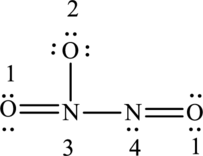
The formal charge for each atom is calculated as,
Formal charge on nitrogen (3)=
Formal charge on nitrogen (4)=
Formal charge on oxygen (1)=
Formal charge on oxygen (2)=
The Lewis formula is,
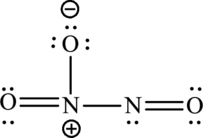
The resonance structures are,

The total number of valence electrons in
Number of valence electrons in oxygen=
Number of valence electrons in nitrogen=
The total number of valence electrons is seventeen.
One nitrogen atom forms bonds with two electrons that means four oxygen electrons helps in forming bonds and the remaining thirteen are used to satisfy the octet rule of atoms.
The Lewis formula is,

There is an incomplete octet on nitrogen and oxygen atoms that can be avoided by adding one-pi bond between nitrogen and one oxygen atoms. The Lewis formula becomes,

The formal charge for each atom is calculated as,
Formal charge on nitrogen=
Formal charge on oxygen (1)=
Formal charge on oxygen (2)=
The Lewis formula is,

The resonance structures are,
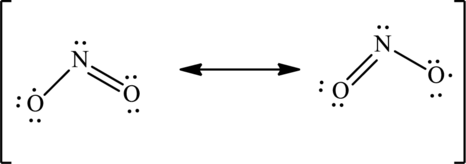
The total number of valence electrons in
Number of valence electrons in oxygen=
Number of valence electrons in nitrogen=
The total number of valence electrons is thirty-four.
Two nitrogen atoms forms bonds with each other and both of them form a bond with two oxygen atoms that means ten electrons helps in forming bonds and the remaining twenty-four are used to satisfy the octet rule of atoms.
The Lewis formula is,
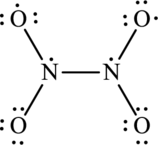
There is an incomplete octet on nitrogen and two oxygen atoms that can be avoided by adding one-pi bond between nitrogen and oxygen atoms. The Lewis formula becomes,
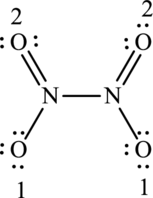
The formal charge for each atom is calculated as,
Formal charge on nitrogen=
Formal charge on oxygen (1)=
Formal charge on oxygen (2)=
The Lewis formula is,
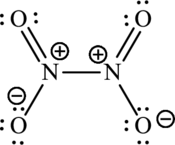
The resonance structures are,

The total number of valence electrons in
Number of valence electrons in oxygen=
Number of valence electrons in nitrogen=
The total number of valence electrons is forty.
Two nitrogen atoms are bonded by one oxygen atom and both of the nitrogen atoms have bonds with two oxygen atoms that means twelve electrons are used to form bonds and remaining twenty-eight are used to satisfy the octet rule of atoms.
The Lewis formula is,
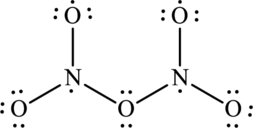
There is an incomplete octet on nitrogen and two oxygen atoms that can be avoided by adding one-pi bond between both nitrogen and oxygen atoms. The Lewis formula becomes,
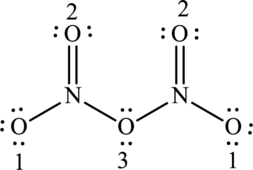
The formal charge for each atom is calculated as,
Formal charge on nitrogen=
Formal charge on oxygen (1)=
Formal charge on oxygen (2)=
Formal charge on oxygen (3)=
The Lewis formula is,
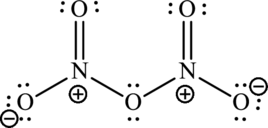
The resonance structures are,

Want to see more full solutions like this?
Chapter 7 Solutions
GENERAL CHEMISTRY ACHIEVE ACCESS W/BOOK
- Indicate the product(s) B and C that are formed in the reaction: HN' OCH HC1 B + mayoritario C minoritario OCH3arrow_forwardIndicate the product(s) that are formed in the reaction: NH-NH, OCH3 -H₂O OCH3arrow_forward21.38 Arrange the molecules in each set in order of increasing acidity (from least acidic to most acidic). OH OH SH NH2 8 NH3 OH (b) OH OH OH (c) & & & CH3 NO2 21.39 Explain the trends in the acidity of phenol and the monofluoro derivatives of phenol. OH OH OH OH PK 10.0 PK 8.81 PK 9.28 PK 9.81arrow_forward
- identify which spectrum is for acetaminophen and which is for phenacetinarrow_forwardThe Concept of Aromaticity 21.15 State the number of 2p orbital electrons in each molecule or ion. (a) (b) (e) (f) (c) (d) (h) (i) DA (k) 21.16 Which of the molecules and ions given in Problem 21.15 are aromatic according to the Hückel criteria? Which, if planar, would be antiaromatic? 21.17 Which of the following structures are considered aromatic according to the Hückel criteria? ---0-0 (a) (b) (c) (d) (e) (h) H -H .8.0- 21.18 Which of the molecules and ions from Problem 21.17 have electrons donated by a heteroatom?arrow_forward1. Show the steps necessary to make 2-methyl-4-nonene using a Wittig reaction. Start with triphenylphosphine and an alkyl halide. After that you may use any other organic or inorganic reagents. 2. Write in the product of this reaction: CH3 CH₂ (C6H5)₂CuLi H₂O+arrow_forward
- 3. Name this compound properly, including stereochemistry. H₂C H3C CH3 OH 4. Show the step(s) necessary to transform the compound on the left into the acid on the right. Bri CH2 5. Write in the product of this LiAlH4 Br H₂C OHarrow_forwardWhat are the major products of the following reaction? Please provide a detailed explanation and a drawing to show how the reaction proceeds.arrow_forwardWhat are the major products of the following enolate alkylation reaction? Please include a detailed explanation as well as a drawing as to how the reaction proceeds.arrow_forward
- A block of zinc has an initial temperature of 94.2 degrees celcius and is immererd in 105 g of water at 21.90 degrees celcius. At thermal equilibrium, the final temperature is 25.20 degrees celcius. What is the mass of the zinc block? Cs(Zn) = 0.390 J/gxdegrees celcius Cs(H2O) = 4.18 J/gx degrees celcusarrow_forwardPotential Energy (kJ) 1. Consider these three reactions as the elementary steps in the mechanism for a chemical reaction. AH = -950 kJ AH = 575 kJ (i) Cl₂ (g) + Pt (s) 2C1 (g) + Pt (s) Ea = 1550 kJ (ii) Cl (g)+ CO (g) + Pt (s) → CICO (g) + Pt (s) (iii) Cl (g) + CICO (g) → Cl₂CO (g) Ea = 2240 kJ Ea = 2350 kJ AH = -825 kJ 2600 2400 2200 2000 1800 1600 1400 1200 1000 a. Draw the potential energy diagram for the reaction. Label the data points for clarity. The potential energy of the reactants is 600 kJ 800 600 400 200 0 -200- -400 -600- -800- Reaction Progressarrow_forwardCan u help me figure out the reaction mechanisms for these, idk where to even startarrow_forward
 ChemistryChemistryISBN:9781305957404Author:Steven S. Zumdahl, Susan A. Zumdahl, Donald J. DeCostePublisher:Cengage Learning
ChemistryChemistryISBN:9781305957404Author:Steven S. Zumdahl, Susan A. Zumdahl, Donald J. DeCostePublisher:Cengage Learning ChemistryChemistryISBN:9781259911156Author:Raymond Chang Dr., Jason Overby ProfessorPublisher:McGraw-Hill Education
ChemistryChemistryISBN:9781259911156Author:Raymond Chang Dr., Jason Overby ProfessorPublisher:McGraw-Hill Education Principles of Instrumental AnalysisChemistryISBN:9781305577213Author:Douglas A. Skoog, F. James Holler, Stanley R. CrouchPublisher:Cengage Learning
Principles of Instrumental AnalysisChemistryISBN:9781305577213Author:Douglas A. Skoog, F. James Holler, Stanley R. CrouchPublisher:Cengage Learning Organic ChemistryChemistryISBN:9780078021558Author:Janice Gorzynski Smith Dr.Publisher:McGraw-Hill Education
Organic ChemistryChemistryISBN:9780078021558Author:Janice Gorzynski Smith Dr.Publisher:McGraw-Hill Education Chemistry: Principles and ReactionsChemistryISBN:9781305079373Author:William L. Masterton, Cecile N. HurleyPublisher:Cengage Learning
Chemistry: Principles and ReactionsChemistryISBN:9781305079373Author:William L. Masterton, Cecile N. HurleyPublisher:Cengage Learning Elementary Principles of Chemical Processes, Bind...ChemistryISBN:9781118431221Author:Richard M. Felder, Ronald W. Rousseau, Lisa G. BullardPublisher:WILEY
Elementary Principles of Chemical Processes, Bind...ChemistryISBN:9781118431221Author:Richard M. Felder, Ronald W. Rousseau, Lisa G. BullardPublisher:WILEY





